How Microplastics Amplify Toxicity Via The Gut-Brain Axis?

Sewage sludges and wastewaters bring high concentrations of microplastics in contact with other environmental pollutants, such as TPT. In such biochemical slurries, microplastics provide large surface areas for adsorption or attachment, becoming carriers for other chemicals and substances. Even the most effective wastewater treatment processes don’t remove microplastics completely. When released into the environment, carrier microplastics mimic the appearance of some natural food items of aquatic species, get ingested, and then deliver adsorbed pollutants directly to their digestive tracts.
They also accumulate in brain tissues, damaging the blood-brain barrier. Since dietary accumulation is an important pathway, the researchers examined how this toxicity manifests upon the “gut-brain axis” – an intricate “information exchange system between the brain and gut, consisting of the neuroendocrine, vagal, and immune pathways.”
Advertisement
The authors conducted exposure experiments with juvenile common carp a widely cultured freshwater fish using realistic environmental concentrations of both pollutants, microplastics and TPT. One group was exposed to each pollutant singly, while a third group was exposed to a combination of both pollutants. The experiments lasted 42 days, and the fish were sampled at regular intervals to evaluate combined toxicity effects on “gut physiology, biochemical parameters, gut microbial 16S rRNA, and brain transcriptome sequencing.”
Microplastics Impact on the Gut-Brain Axis
The study detected that the pollutants both when acting singly, and in combination.
had toxic manifestations for the carp’s gut-brain axis, but with important differences. When acting alone, microplastics mainly suppressed immunity, while TPT interfered with lipid metabolism. However, when combined, TPT amplified the immunotoxicity of microplastics.
Histopathological examination showed that exposure to both microplastics and TPT increased the area and density of gut glycoproteins, an immunomodulatory component of intestinal mucus secreted by goblet cells, when compared to controls and single pollutants. The authors explain this as, “the gut having protected itself against foreign microplastics and TPT by stimulating glycoprotein secretion to improve the functioning of the intestinal barrier.”
Further biochemical assessments and genetic sequencing of the carp’s gut microflora and brain tissues provided further evidence of amplified toxicity under co-exposure. 16s-rDNA sequencing of the gut microbiome coupled with Kyoto Encyclopaedia of Genes and Genomes (KEGG) analyses showed an increased complexity of the bacterial network under co-exposure, with a reduced abundance of genera important for proper immune functioning. This could contribute to increased glycoprotein levels as compensatory mechanism to maintain immune functioning.
Examining the carp’s brain with transcriptome analysis to detect differentially expressed genes (DEGs), they found that microplastics acting alone mainly decreased some DEGs related to immune functioning, while TPT combined with microplastics reduced the expression levels of the same genes related to immunity significantly more. TPT alone increased lipid metabolism DEGs levels. This finding led them to conclude that, “the combination of microplastics and TPT amplifies the immunotoxicity of microplastics acting alone.”
A correlation analysis of gut parameters with carp brain metabolism genes for both immunity and lipid metabolism pathways further showed that the abundance of bacteria in the intestine of carp was significantly correlated with expression levels of DEGs in the carp brain related to immunity, while little correlation was present with lipid metabolism genes, providing a consistent story on how TPT amplifies the toxicity of microplastics on the carp’s immune system via the gut-brain communication channel.
Continued research in this area will contribute to our understanding of the environmental and health implications of combined exposure to common pollutants and support the development of strategies to mitigate their adverse effects on ecosystems and human well-being.
Source: Eurekalert
Source link
#Microplastics #Amplify #Toxicity #GutBrain #Axis



